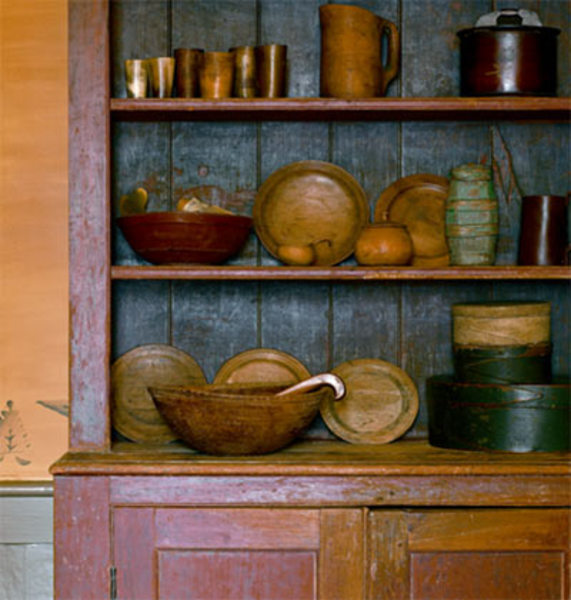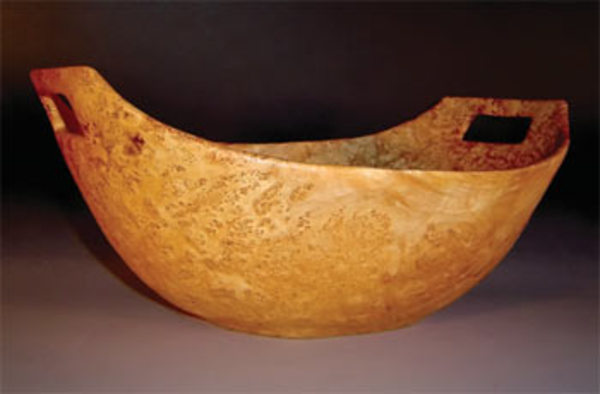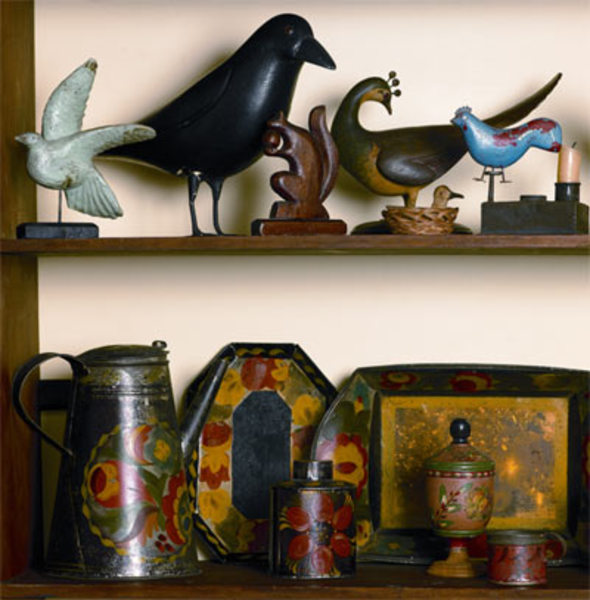
Treenware plates, bowls, and a pitcher or two coordinate peacefully with other wood items on a cupboard with aged milk paint.
Treen is made of wood and tole is made of metal, but both forms flourished as a means of artistic expression in 18th- and 19th-century America. Treen, the older of the two, was the standard tableware in Europe when the first colonists began to arrive in the early 1600s. Even at that early date, most treen was lathe-turned. Early Americans may have found themselves copying Native American techniques, literally carving dishware out of pieces of felled trees and smoothing individual platters and trenchers with a drawknife.
Early treenware can be either carved or lathe- turned—or some combination of the two, as an unusual example in the collection of Old Sturbridge Village demonstrates. Made from an ash burl (a type of large tree blister that lends itself to a bowl shape in the hands of an expert carver), the simplest parts of this bowl were turned on a lathe, while the pouring lip and three handles (one is a V-shaped spout) were carved, smoothed with a drawknife, and shaved. Other early pieces include all sorts of spoons and ladles, nut crackers, needle holders, rolling pins, and butter presses and scrapers.
At some point—possibly about the time of the “fancy” painted furniture rage of the early 1800s—it became fashionable to coat the exterior of treenware with milk paint. In authentic pieces, the working part of the treen is often severely scarred from food preparation; the outside of the bowl or plate displays an appealing distressed quality. Collectors typically display the backside of the bowl to capture the visual impact of ancient wood peeking though wisps of aged paint. Signs of use and wear and age—patina, even warping—are also highly desirable.

A hand-hewn bowl by Burl Treen in burl ash; the open handles were inspired by a historical piece.
Short of clear provenance, it can be all but impossible to estimate the true age of a piece of treenware, although evidence of first-growth wood is a good indicator. Even fine antiques are rarely signed; most vintage treenware on the market probably dates to the mid-19th or early 20th centuries. Prices range from less than $20 (for pieces of recent age) to $500 or more.
Reproductions and modern craft interpretations of treenware abound, so if your purpose is purely decorative, these are worth considering. Inexpensive reproductions in resin ($25 or less) are usually made from castings of very old pieces. Contemporary reproductions in wood tend to be more costly, because they are handmade by skilled craftspeople who are rightly considered artists, like Shaari Horowitz and Michael Combs.
Toleware is nearly as hard to identify and place as treenware. Decorated tinplate caught on in Europe in the first half of the 18th century, and the first pieces to arrive here were imported, as were the thinly milled, tin-plated sheets themselves. About 1750, Edward Pattison began making tinplate wares in his shop near Hartford, Connecticut. Toleware manufacture blossomed after the Revolutionary War in family workshops in Connecticut, Maine, New York, and Pennsylvania. The men worked the tin and peddled it from town to town, while their wives and daughters “flowered” the finished pieces with paint. Prominent makers include the Stevens and Buckley shops near Portland, Maine; the Boynton Shop in Massachusetts; the North Shop in Otsego County, New York; and the Butler Shop in Green County, New York.

A shelf full of early Pennsylvania toleware includes a rare piece with crystallization. right, top: An early-20th-century tin pan with tole decoration, from Hidden Treasures.
Decorators copied designs found on imported ceramics of the period, but there’s nothing quite like the blooming florals in red, ochre, and yellow on the black and green grounds of American toleware. Regional variations were felt most strongly in 19th-century Pennsylvania, where handmade pieces continued into the 1870s.
They include brilliant red backgrounds and crystallization, created by applying muriatic acid to an unpainted surface. Pennsylvania artisans used a great deal of “thumb work”—a technique in which paint colors are applied and blended with a finger or thumb. Favorite motifs include large ochre shapes with black work; circles on thinly painted white; and white blanks filled with flowers and fruit.
In New Hampshire and later Massachusetts, John Boynton made tinware decorated with stenciling rather than free-hand painting. While stenciling may sound simple, in one of his highly sophisticated pieces multiple colors are washed over metallic powders stenciled onto asphaltum. Because the ground softened easily, many layers were necessary to create the design.
Toleware forms suggest fancy display and storage. Typical pieces include trays, cheese cradles (in a distinctively curved shape to hold a circular cheese), teapots and caddies, breadboxes, and document boxes. Early toleware should show evidence of hand manufacture and hand painting or stenciling. Expect to pay $100 to $1,000 or more for an authentic 19th-century piece in good condition. While 20th-century reproductions from around the world are legion (think Mexico, China, and Taiwan), many pieces from the 1920s to 1940s exhibit the same painting techniques, compositions, and color combinations as the earlier forms. They’re priced well, too: $50 or less in many instances.







